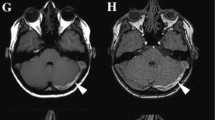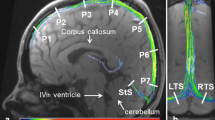Abstract
Objectives
To compare time-resolved imaging of contrast kinetics (TRICKS) magnetic resonance angiography (MRA) with two-dimensional time-of-flight (TOF) magnetic resonance venography (MRV), and three-dimensional contrast-enhanced (CE) MRV in the visualisation of normal cerebral veins and dural venous sinuses.
Methods
This prospective study consisted of 35 consecutive patients. All patients were examined with TOF MRV, TRICKS MRA and CE MRV; a single dose of intravenous contrast material was administered for the last two sequences. The image quality of these techniques was assessed and compared qualitatively (by a semiquantitative scoring system) and quantitatively (by calculating signal-to-noise ratios [SNRs] and contrast-to-noise ratios [CNRs]).
Results
Left transverse sinus, left sigmoid sinus, bilateral thalamostriate veins and Trolard veins were better visualised by TRICKS MRA and CE MRV compared with TOF MRV (P < 0.05). For left thalamostriate vein visualisation, TRICKS MRA was inferior to CE MRV (P < 0.05). With quantitative analysis the SNRs and CNRs were highest at TRICKS MRA, which was followed by CE MRV and TOF MRV (P < 0.05).
Conclusions
Despite its limited spatial resolution, TRICKS MRA is comparable to static CE MRV and better than TOF MRV in the visualisation of normal dural sinuses and cerebral veins.
Key Points
• Time resolved magnetic resonance angiography can image the intracranial venous system dynamically
• It seems comparable to contrast-enhanced MRV techniques in venous visualisation
• The optimal phase for venous structures can be chosen from the dynamic data set
• The diagnostic performance in venous thrombosis requires further research




Similar content being viewed by others
References
Agid R, Shelef I, Scott JN et al (2008) Imaging of the intracranial venous system. Neurologist 14:12–22
Sheerin F (2009) The imaging of the cerebral venous sinuses. Semin Ultrasound CT MR 30:525–558
Sun J, Wang J, Jie L et al (2010) Visualization of the internal cerebral veins on MR phase-sensitive imaging: comparison with 3D gadolinium-enhanced MR venography and fast-spoiled gradient recalled imaging. AJNR Am J Neuroradiol. doi:10.3174/ajnr.A2308
Wang J, Wang J, Sun J et al (2010) Evaluation of the anatomy and variants of internal cerebral veins with phase-sensitive MR imaging. Surg Radiol Anat 32:669–674
Fujii S, Kanasaki Y, Matsusue E et al (2010) Demonstration of cerebral venous variations in the region of the third ventricle on phase-sensitive imaging. AJNR Am J Neuroradiol 31:55–59
Meckel S, Glücker TM, Kretzschmar M et al (2008) Display of dural sinuses with time-resolved, contrast-enhanced three-dimensional MR venography. Cerebrovasc Dis 25:217–224
Fu JH, Lai PH, Hsiao CC et al (2010) Comparison of real-time three-dimensional gadolinium-enhanced elliptic centric-ordered MR venography and two-dimensional time-of-flight MR venography of the intracranial venous system. J Chin Med Assoc 73:131–138
Lettau M, Sartor K, Heiland S et al (2009) 3T high-spatial-resolution contrast-enhanced MR angiography of the intracranial venous system with parallel imaging. AJNR Am J Neuroradiol 30:185–187
Kirchhof K, Welzel T, Jansen O et al (2002) More reliable noninvasive visualization of the cerebral veins and dural sinuses: comparison of three MR angiographic techniques. Radiology 224:804–810
Farb RI, Scott JN, Willinsky RA et al (2003) Intracranial venous system: gadolinium-enhanced three-dimensional MR venography with auto-triggered elliptic centric-ordered sequence – initial experience. Radiology 226:203–209
Cornfeld D, Mojibian H (2009) Clinical uses of time-resolved imaging in the body and peripheral vascular system. AJR Am J Roentgenol 193:W546–W557
Saleh RS, Lohan DG, Villablanca JP et al (2008) Assessment of craniospinal arteriovenous malformations at 3T with highly temporally and highly spatially resolved contrast-enhanced MR angiography. AJNR Am J Neuroradiol 29:1024–1031
Petkova M, Gauvrit JY, Trystram D et al (2009) Three-dimensional dynamic time-resolved contrast-enhanced MRA using parallel imaging and a variable rate k-space sampling strategy in intracranial arteriovenous malformations. J Magn Reson Imaging 29:7–12
Vattoth S, Cherian J, Pandey T (2007) Magnetic resonance angiographic demonstration of carotid-cavernous fistula using elliptical centric time resolved imaging of contrast kinetics (EC-TRICKS). Magn Reson Imaging 25:1227–1231
Farb RI, Agid R, Willinsky RA et al (2009) Cranial dural arteriovenous fistula: diagnosis and classification with time-resolved MR angiography at 3T. AJNR Am J Neuroradiol 30:1546–1551
Meckel S, Maier M, Ruiz DS et al (2007) MR angiography of dural arteriovenous fistulas: diagnosis and follow-up after treatment using a time-resolved 3D contrast-enhanced technique. AJNR Am J Neuroradiol 28:877–884
Zou Z, Ma L, Cheng L et al (2008) Time-resolved contrast-enhanced MR angiography of intracranial lesions. J Magn Reson Imaging 27:692–699
Oleaga L, Dalal SS, Weigele JB et al (2010) The role of time-resolved 3D contrast-enhanced MR angiography in the assessment and grading of cerebral arteriovenous malformations. Eur J Radiol 74:e117–e121
Meckel S, Mekle R, Taschner C et al (2006) Time-resolved 3D contrast-enhanced MRA with GRAPPA on a 1.5-T system for imaging of craniocervical vascular disease: initial experience. Neuroradiology 48:291–299
Reinacher PC, Stracke P, Reinges MH et al (2007) Contrast-enhanced time-resolved 3-D MRA: applications in neurosurgery and interventional neuroradiology. Neuroradiology 49:S3–S13
Meckel S, Reisinger C, Bremerich J et al (2010) Cerebral venous thrombosis: diagnostic accuracy of combined, dynamic and static, contrast-enhanced 4D MR venography. AJNR Am J Neuroradiol 31:527–535
Mermuys KP, Vanhoenacker PK, Chappel P et al (2005) Three-dimensional venography of the brain with a volumetric interpolated sequence. Radiology 234:901–908
Wetzel SG, Johnson G, Tan AG et al (2002) Three-dimensional, T1-weighted gradient-echo imaging of the brain with a volumetric interpolated examination. AJNR Am J Neuroradiol 23:995–1002
Chen Q, Quijano CV, Mai VM et al (2004) On improving temporal and spatial resolution of 3D contrast-enhanced body MR angiography with parallel imaging. Radiology 231:893–899
Ruhl KM, Katoh M, Langer S et al (2008) Time-resolved 3D MR angiography of the foot at 3T in patients with peripheral arterial disease. AJR Am J Roentgenol 190:W360–W364
Niendorf T, Sodickson DK (2006) Parallel imaging in cardiovascular MRI: methods and applications. NMR Biomed 19:325–341
Shoukri MM (2004) Measures of interobserver agreement and reliability. Chapman & Hall/CRC, Boca Raton, FL, USA
Author information
Authors and Affiliations
Corresponding author
Electronic supplementary material
Below is the link to the electronic supplementary material.
Collapsed sagittal images of 20 contrast-enhanced temporal phases of TRICKS MRA (MPG 1193 kb)
Rights and permissions
About this article
Cite this article
Yiğit, H., Turan, A., Ergün, E. et al. Time-resolved MR angiography of the intracranial venous system: an alternative MR venography technique. Eur Radiol 22, 980–989 (2012). https://doi.org/10.1007/s00330-011-2330-0
Received:
Revised:
Accepted:
Published:
Issue Date:
DOI: https://doi.org/10.1007/s00330-011-2330-0




